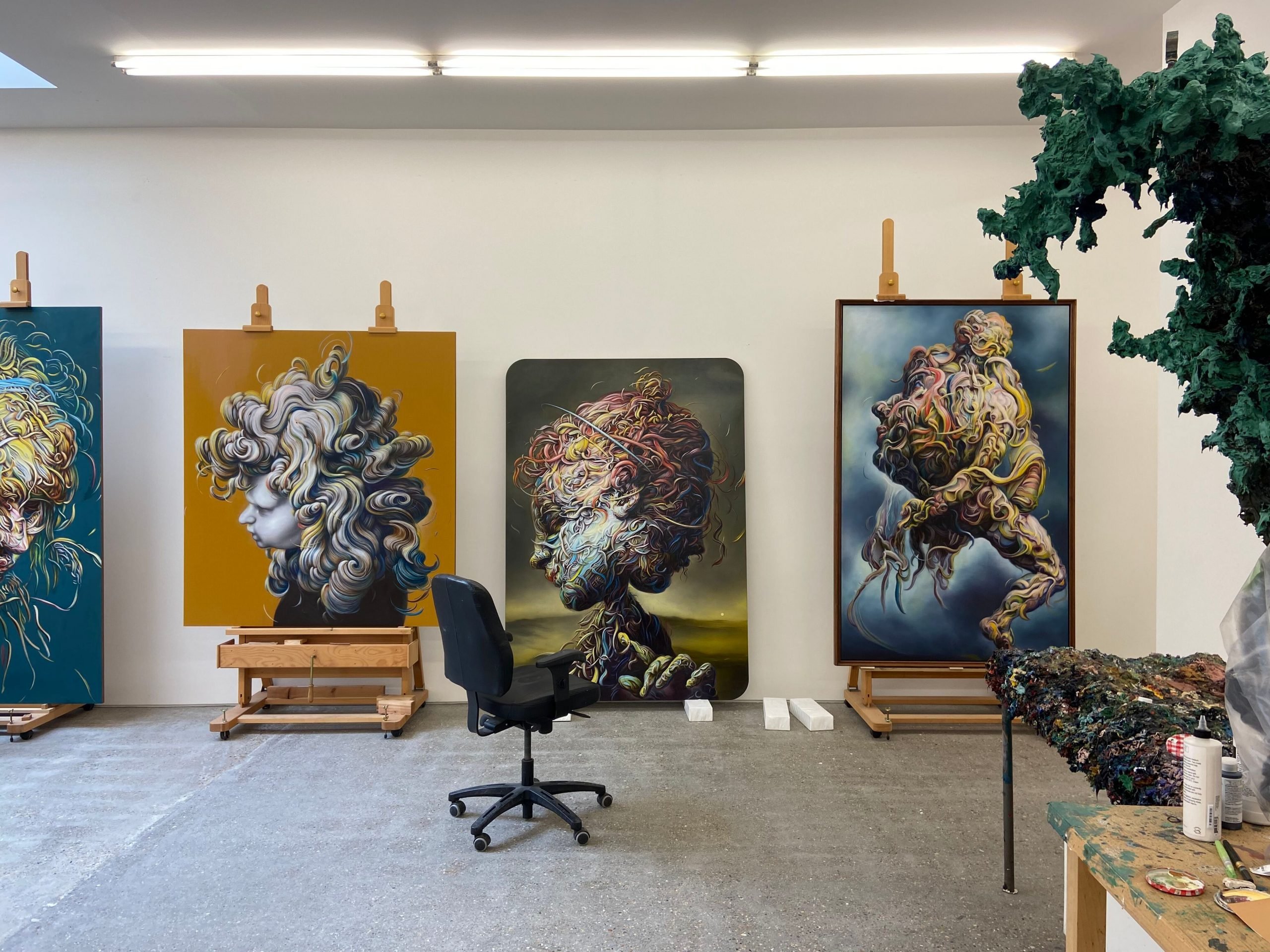
Glenn Brown is an artist who finds unceasing inspiration in art history. The British painter recently opened the Brown Collection, which debuted with an exhibition of his own art, in a restored house in London’s Marylebone neighborhood. Works on view range from early appropriations of Frank Auerbach and Jean-Honoré Fragonard to layered portraits that put a twist on Renaissance Old Masters. In the future, Brown plans to display his work alongside older paintings, drawings, and sculptures from his private collection.
It makes sense, then, that Brown’s studio is also a tribute to the art and aesthetics of the past. Brown’s Shoreditch workspace houses treasures like a 15th century woodcut, a 20th century watercolor, and a selection of 17th and 18th century ornate frames. The artists behind these works are rarely household names; instead, they are representative of the unique way an artist like Brown assesses historic art.
Several of these objects also served as inspirations for his latest exhibition, “We’ll Keep On Dancing Till We Pay the Rent,” which opens at Gagosian’s Chelsea gallery on November 8. The show—the artist’s first in New York since 2014—takes drawing as a jumping off point. Each painting based on an appropriated drawing from artists ranging from Pompeo Batoni (1708–1787) and Andrea del Sarto (1486–1530) to Jan Willem Pieneman (1779–1853) and Jan Van Noordt (1623/4–after 1676).
Ahead of the exhibition’s opening, Brown opened up his studio for Artnet News to take a peek inside.
Glenn Brown at work. Photo courtesy of Glenn Brown.
Tell us about your studio. Where is it, how did you find it, what kind of space is it?
I’ve had various studios in Shoreditch since 1991 and moved into my current studio in 2010. I love it because it’s very light because of the huge skylight and it is very quiet.
What is the first thing you do when you walk into your studio (after turning on the lights)?
Try to understand how delusional I was the night before.
How many studio assistants or other team members do you have working with you, and what do they do?
I don’t have any assistants in the studio.
What are you working on right now?
I just finished a show of new paintings, sculptures, and drawings for a show at Gagosian in New York—”We’ll Keep On Dancing Till We Pay the Rent”—which opens on November 8.
Show us a few different photos of a work in progress in a way that you think will provide insight into your process.
At work in the studio. Courtesy of Glenn Brown.
Glenn Brown at work. Photo courtesy of Glenn Brown.
What tool or art supply do you enjoy working with the most?
Oil paint. It’s gorgeous.
How do you know when an artwork you are working on is clicking?
When a painting starts to answer back. The work tells me what to do. In other words, it gains a personality that isn’t quite mine.
Do you have any other artist’s work in your studio?
Austin Osman Spare (1886–1956), Green Sidereal, watercolor and pencil on card. Courtesy of Glenn Brown.
I used the colors from this work for one of my new paintings for the November show, Dirty Creamer (2022). I love Osman Spare’s delicate pencil lines.
Glenn Brown, Dirty Creamer (2022). © Glenn Brown. Photo: Prudence Cuming Associates Ltd. Courtesy Gagosian.
Spare often draws without taking the pencil off the paper, a wonderful little trick that creates a mesmerizing fluid line.
Hendrick Goltzius, (1558–1617), Hercules Killing Cacus, chiaroscuro woodcut print. Courtesy of Glenn Brown.
Goltzius was a technical genius who was very inventive. His ability to trick the eye will never be beaten.
What is the fanciest thing in your studio?
I have a large collection of antique frames, mostly 17th and 18th century Italian. I use antique frames as a starting point for many of my drawings.
Glenn Brown’s frame collection. Photo courtesy of Glenn Brown.
Is there anything in your studio that a visitor might find surprising?
It’s very tidy, which people seem to find quite disturbing.
When you feel stuck while preparing for a show, what do you do to get unstuck?
I get a friend to come to the studio to help me look at the paintings as if I haven’t seen them before.
What historical artist do you think about the most when you’re in your studio and why?
Sometimes I have a François Boucher kind of obsession; sometimes I fancy Abraham Bloemaert; some days it’s Andrea del Sarto.
Hendrick Goltzius’s drawing of a hand at the Teylers Museum.
What’s the last museum exhibition or gallery show you saw that really affected you and why?
It was a trip to Haarlem, the Netherlands and a visit to the drawing room of the Teylers Museum.
I requested to see their Hendrick Goltzius drawings, including A Hand, which I have previously seen reproductions of, but seeing the real drawing was magnificent.
What do you like to do after you leave the studio at the end of the day?
I often paint until the early hours of the morning. Most days I leave the studio and get back home and go straight to bed.
“Glenn Brown: We’ll Keep On Dancing Till We Pay the Rent” is on view at Gagosian New York, 541 West 24th Street, from November 8 through December 23.
More Trending Stories:
Disgraced Antiques Dealer Subhash Kapoor Handed a 10-Year Jail Sentence by an Indian Court